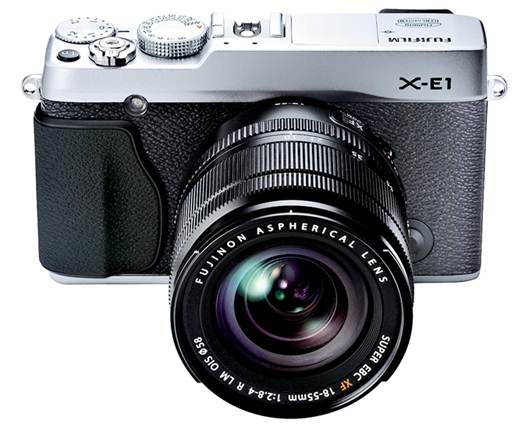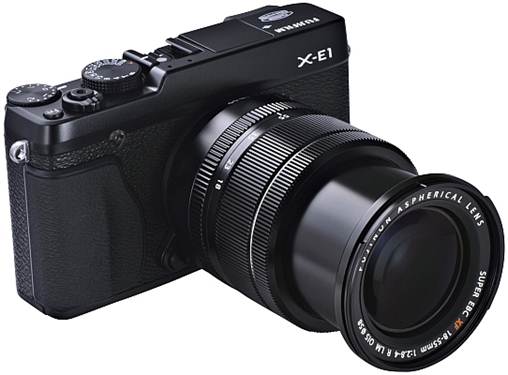Fujifilm launched the X system earlier this
year with the X-Pro 1. Although the camera was well received, its pricing
seemed likely to limit its appeal. Targeted at professionals and enthusiasts,
the new X-E1 aims to further strengthen the X system's appeal to a wider range
of enthusiasts with its solid metal body and analogue dial led control.

Fujifilm
X-E1
For a mirrorless interchangeable lens
camera, the X-E1 has an APS-C sized sensor, much larger than the micro-four
thirds sensors introduced by Panasonic and Olympus with their mirrorless
cameras, or even the Nikon I system sensors.
Look, body and feel
In terms of dimensions, the X-E1 is
considerably smaller than the X-Pro 1, brought about by the removal of the
optical viewfinder and its replacement by a fully-electronic one in its place.
In terms of design, with the exception of the optical viewfinder and its
associated mode switch, it's almost exactly the same as the X-Pro 1. The X-E1
has a built-in flash, something the X-Pro 1 didn't have. That apart,
structurally, little has changed.
The grip provided by the camera is amazing,
and it seemed like a perfect fit in my hands. The analogue dial led interface
makes the shooting experience with this camera very different from some of the
new cameras out in the market. All key functions are well placed and easily
accessible. Can't think of anything Fujifilm could have improved in terms of
ergonomics. The solid-metal body is sturdy but a little on the heavy side. It
seems fully capable of withstanding a little rough use.

Made
in Japan, the X-E1 exudes a class and quality that can be seen from each of its
components.
Control over the camera is based around
traditional analogue dials - exposure compensation and shutter speed dials are
on the top panel, and the aperture is controlled by a ring on the lens. The
back of the camera offers lots of buttons for direct access to a variety of the
camera's functions, including a Q button that brings up a control screen
allowing you to change many of the camera's settings.
Performance
Among the new features relative to the
X-Pro 1, the X-E1 has a built-in flash and also the ability to use an
electronic shutter release cable in addition to the threaded shutter release
button.
It uses the same 16 MP X-Trans CMOS APS-C
sensor and EXR Pro image processor as the X-Pro 1. Both photo and video quality
is truly impressive, with excellent colour reproduction and detail. Even the
stereo quality audio recording is crisp and clear.
The X-Pro 1's hybrid viewfinder was integral
to its overall user experience, and although losing it with the X-E1 might seem
like a big mistake, it uses a 2.36M dot OLED viewfinder, an improvement from
the X-Pro 1's 1.44M dot LCD finder, making the camera more compact. The
electronic viewfinder is comparable to other mirrorless interchangeable lens
cameras of its class.
We weren't particularly happy with the
camera's autofocus abilities, although it has apparently been improved in
comparison with the X-Pro 1. Manual focus is also cumbersome and the dial isn't
as responsive as we'd have liked, despite it being performed with the aperture
set wide open. The rear screen has been somewhat downgraded both in terms of
size and resolution, but still holds its own.

The
Fujifilm X-E1 is a sixteen-megapixel compact system camera with a
2.36-million-dot EVF, fast auto-focus and a built-in flash
The Fujinon XF 18-55mm F2.8-4 R LM OIS is
the first zoom lens in Fujifilm's relatively newXF line-up, and is bundled with
the X-E1 as a kit lens. It has an angle of view comparable to that of a 27-84mm
lens in a 35mm system. The aperture mode switch on the lens toggles between the
auto aperture control and manual aperture control. Its overall build quality is
excellent, and in line with the X-series bodies. The lens also has a built-in
OIS (Optical Image Stabiliser) which can be turned on and off via a dedicated
OIS switch on the lens barrel.
ISO Performance
The Fujifilm X-E1 can only boost ISO up to
6400. The resufts however are acceptable even at ISO 3200, with sharpness
intact and only a minimum amount of noise.
Look, Body & Feel Rating
Well styled, robust ergonomic design
Performance Rating
Excellent colour reproduction. Slow
autofocus/manual focus
Overall Rating
Good value for money
Conclusion
Impressive image quality coupled with the
camera's analogue dial led control philosophy makes this one exciting camera to
work with. Priced at just ?70,000, the Fujifilm X-E I comes bundled with an 18-55mm
1:2.8-4 lens, and we think it is an excellent buy.
|
Model name: FUJIFILM X-E1
·
Number of effective pixels: 16.3 million pixels
·
Image sensor: 23.6mm
x 15.6mm (APS-C) X-Trans CMOS with primary colour filter Sensor Cleaning
system Ultra Sonic Vibration
·
Storage media: SD
memory card / SDFIC memory card / SDXC (UHS-I) memory card
·
File format: Still
image JPEG (Exif Ver 2.3) RAW (RAF format), RAW+JPEG
(Design rule for Camera File system compliant / DPOF- compatible)
movie H.264 (MOV) with Stereo sound
·
Lens mount: Fujifilm X mount
·
Sensitivity: Equivalent
to ISO 200 - 6400 (Standard Output Sensitivity) AUTO mode: AUTO (400) /AUTO
(800) /AUTO (1600) / AUTO (3200) / AUTO(6400)
·
Extended output sensitivity equivalent ISO
100, 1280
·
Accessories included: Li-ion battery NP-W126 Battery charger BC-W126 Shoulder strap USB
cable Body cap Metal strap clip Protective cover Clip attaching tool
·
CD-ROM (Viewer software, RAW File Converter
etc.) Owner’s manual
|